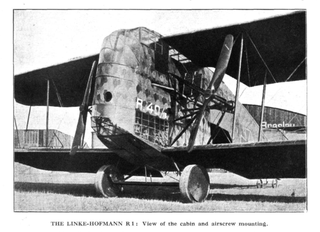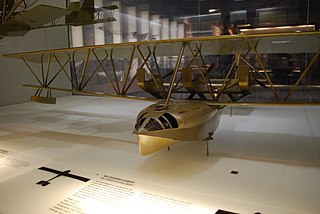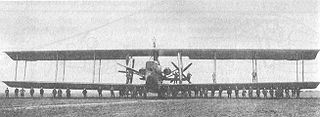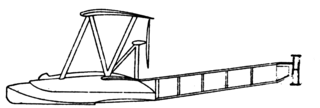| Zeppelin-Staaken R.VII | |
|---|---|
| Role | Bomber |
| National origin | German Empire |
| Manufacturer | Flugzeugwerft GmbH, Staaken, Berlin |
| Designer | Graf von Zeppelin |
| First flight | 1917 |
| Primary user | Luftstreitkräfte |
| Number built | 1 |
The Zeppelin-Staaken R.VII was six-engined large bomber - a Riesenflugzeug - of Imperial Germany, intended to be less vulnerable than the airships in use at the time.
The R.VII, an incremental improvement on the almost identical Zeppelin-Staaken R.IV, had two engine pods, each with tandem pusher engines, large enough for some inflight maintenance by flight mechanics housed in cockpits forward of the nacelle engines, driving the large pusher propellers through clutches, gearboxes, and shafts. A further two engines were mounted in the nose of the fuselage, driving a single tractor propeller in a similar fashion. [1]
First flown early in 1917, the sole R.VII (R.14/15) was accepted by the Deutsche Luftstreitkräfte (Imperial German Air Service) on 3 July 1917 and assigned to Rfa 501 on 29 July 1917. Used in operations on the Western Front, the R.VII had a short operational life, crashing due to a clutch failure and the incorrect actions of a flight mechanic, with the loss of six crew members. [1]
Data fromThe German Giants, [1]
General characteristics
Performance
Armament

The AEG R.I or Riesenflugzeug 1 was a four-engined biplane bomber aircraft of World War I manufactured by AEG.

The Zeppelin-Staaken R.VI was a four-engined German biplane strategic bomber of World War I, and the only Riesenflugzeug design built in any quantity.

The Linke-Hofmann R.I was a heavy bomber aircraft designed and built by the German company Linke-Hofmann during World War I. Only four were built and the type never saw service with the Luftstreitkräfte.

The Linke-Hofmann R.II was a bomber aircraft designed and built in Germany from 1917.
The DFW R.I,, was a prototype German bomber aircraft of World War I.

The DFW R.II was a German bomber aircraft of World War I. It was developed at a request by the Luftstreitkräfte in spring 1917 after their experience with the R.I had been generally positive, but only two were ever built despite six being ordered.

The Zeppelin-Lindau Rs.I was a large three-engined biplane flying boat designed by Claudius Dornier and built during 1914–15 on the German side of Lake Constance. It never progressed beyond taxiing trials as it was destroyed in a storm.

The Siemens-Schuckert R.VIII was a bomber aircraft designed and built in Germany from 1916.

The Siemens-Schuckert R.II was a prototype bomber aircraft built in Germany during World War I. It was one of six aircraft based on the Siemens-Schuckert R.I that were originally intended to be identical, but which each developed in a different direction and were designated as different aircraft types by the German Inspectorate of Flying Troops. Although the R.II was the first of the batch to be completed, it was the last accepted into military service, and then only as a trainer.
The Siemens-Schuckert R.III was a prototype bomber aircraft built in Germany during World War I. It was one of six aircraft based on the Siemens-Schuckert R.I that were originally intended to be identical, but which each developed in a different direction and were designated as different aircraft types by the German Inspectorate of Flying Troops. The aircraft's development was impeded by the unreliability of its Maybach HS engines, and when it was eventually accepted for military service, it was only in a training role.

The Siemens-Schuckert R.VII was a bomber aircraft built in Germany during World War I. It was one of six aircraft based on the Siemens-Schuckert R.I that were originally intended to be identical, but which each developed in a different direction and were designated as different aircraft types by the German Inspectorate of Flying Troops.

The Zeppelin-Staaken E-4/20 was a revolutionary four-engine all-metal passenger monoplane designed in 1917 by Adolf Rohrbach and completed in 1919 at the Zeppelin-Staaken works outside Berlin, Germany. The E-4/20 was the first four-engine, all-metal stressed skin heavier-than-air airliner built.

The Zeppelin-Staaken R.XVI(Av) was a very large bomber (Riesenflugzeug), designed and built in Germany during 1918.
The Zeppelin-Staaken R.XV was an Imperial German bomber of World War I. An incremental improvement to the Zeppelin-Staaken R.VI, this was one of a series of large strategic bombers called Riesenflugzeuge, intended to be less vulnerable than dirigibles in use at the time.

The Zeppelin-Staaken R.V was one of a series of large bombers called Riesenflugzeugen, intended to be less vulnerable than the rigid airships in use at the time.

The Zeppelin-Staaken Riesenflugzeuge were a series of very large bomber aircraft - Riesenflugzeuge, usually powered by four or more engines, designed and built in Germany from 1915 to 1919.

The Zeppelin-Lindau Rs.II was a biplane flying boat, designed by Claudius Dornier and built during 1914-15 on the German side of Lake Constance. Initially this aircraft was powered by three engines mounted inside the hull driving three pusher propellers via gearboxes and shafts. The later version was powered by four engines in two push-pull nacelles mounted between the wings.

The Zeppelin-Lindau Rs.III was a large four-engined monoplane flying boat designed by Claudius Dornier and built during 1917 on the German side of Lake Constance at the Zeppelin-Lindau works.

The Zeppelin-Lindau Rs.IV was a Riesenflugzeug monoplane all metal flying boat with a stressed skin hull an fuselage developed for the Imperial German Navy to perform long range patrols over the North Sea. It had been developed by Claudius Dornier while working for Zeppelin in the town of Lindau.

The Lloyd 40.08 Luftkreuzer was a three engine triplane bomber type built during World War I. The design was proven to be ineffective and development did not proceed past the prototype stage.
| Wikimedia Commons has media related to Zeppelin-Staaken . |